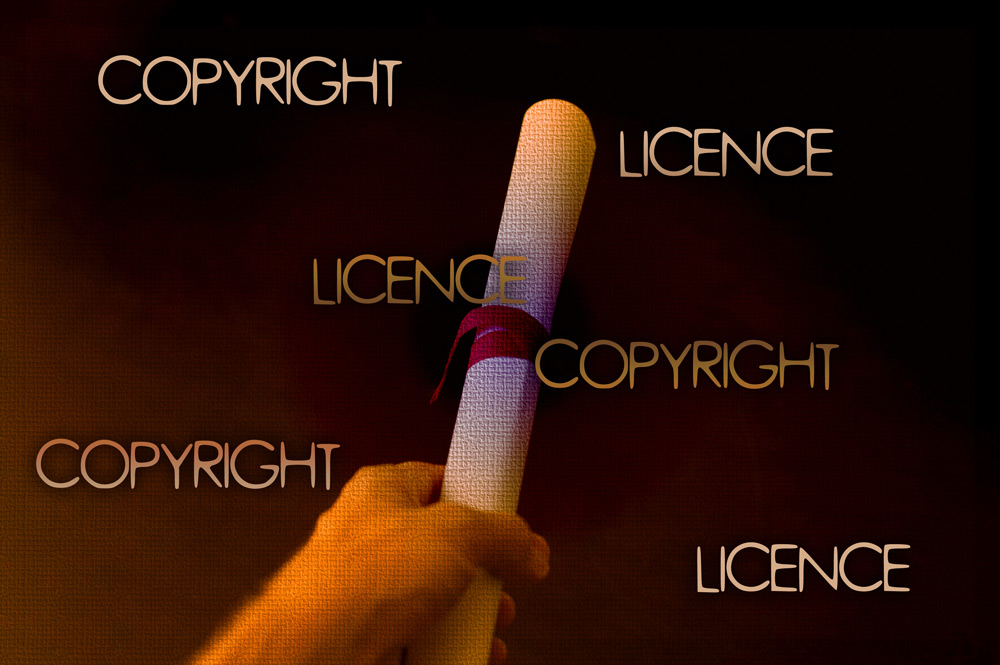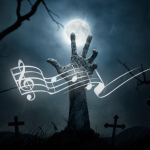Licensing. Do you have it? Probably not.
You may well have clicked on this because you are worried about artists, producers and music companies pulling up in an unmarked van and kicking down your door demanding unpaid royalties for using their work without the proper licence (good luck with anyone trying to find me – not even DHL can seem to find their way to my door – but then DHL couldn’t find their own arse with a mirror).
Sad though it is, it could actually happen.
The issue here is for those indie-authors looking to create a book without paying an absolutely scandalous amount of money to do so.
Many people simply grab a glass of whisky (or perhaps coffee) and sit down in front of their browser. A few clicks later and the magic of Google Images does its stuff and *poof* you’ve found the images that you want. Now, you’re probably aware (or at least you should be) that virtually all of the images that you find are copyrighted. You have to contact the owner and then beg, plead, or just throw some money at them in order to obtain a licence allowing you to use the said artwork in your brand-spanking new book cover. No problem.
Of course, unless you find yourself dealing with a very reasonable chap/lass then you’ll probably wish you never sat down and looked on Google Images in the first place. The cost for some licences could mean you’ll spend the next 10 years trying to break even on that little book you spent so much time and effort publishing.
If you can’t draw then grab a camera (you don’t even need a DSLR – although I strongly recommend one) and take photos of things you’d like to use in your cover. Start building in Photoshop or your editor of choice. Practice makes perfect. There are hundreds of apps available for smart phones these days that let those not comfortable using Photoshop to reproduce similar effects. You can turn your photos into sketches and drawings with little fuss.
The warning regarding licensing is also true when using fonts for book covers (and those fonts you use in print editions of your book). Many are not free or only have a licence for personal usage. You can find entirely free fonts at a number of places (I will include resource links at the end of this article). You could also create your own font if artistically inclined by using software like Fontographer or use a website that creates a font for you based upon your own handwriting (or that of a good friend with nice handwriting who also won’t sting you later on when you’re a big and successful author).
You can also run into licence problems when using Photoshop or Illustrator. Those fantastic ‘free’ brushes and vectors that you downloaded and used on your friend’s birthday card might not have a licence letting you use them for your book.
It’s crazy I know, but if in doubt it’s probably better to ask. People spend time and money creating these things and, quite rightly, expect something in return. It’s not always the situation that they will want a suitcase of freshly-pressed money. There are creators out there that are happy for you to make use of the things they have made/designed to further your own creation in return for an acknowledgment. Sadly, these people are few and far between.
If we take that same scenario and look at indie-authors who create book trailers we find that it is not much different. You need to think about the fonts and images that you intend to use. In addition, you need to consider background music.
We all have our favourite songs. We all hear them playing in our heads as we write. Then we create a book trailer and decide to add some background music… then all of a sudden, in a darkened room, a red light flashes, sirens blare, and the men in suits spring into action. They knock back their coffee (finger extended of course), put out the cat, and leap into the van. Before you know it they’re kicking down your door and suing your arse for everything they can get their hands on. Why? Because you’re ‘stealing’ someones work and making people who are already incredibly wealthy a little less so.
Okay, so maybe they forget to put the cat out once in a while or change from drinking coffee and go for tea instead, the point is that finding a legal way to use background music is a very frustrating and time consuming slog that usually gets you nowhere. The companies have a point regarding the illegal use of music. If someone used pages of your book to advertise their own work then that might annoy you enough to kick down their door also. Then again, you might not mind, just so long as it was made clear that it was your work and not theirs.
So, if you are musically talented (along with being a great artist and a great writer of course) then you can go and make your own tunes. Of course, if you wrote a picture book for kids, but really like thrashing your guitar to death metal then it’s going to be a really interesting book trailer, but not one likely to help you promote your book.
The vast majority of us aren’t able to create the music that we want so we decide to use a track that we bought on Vinyl, Cassette, CD, MiniDisc, or MP3 (or maybe just one of those mediums). It sucks if you did buy all of these old formats over the years as, despite your loyalty, you still have no right to do anything with them other than listen to them (that’s right, even creating home movies with your favourite band rocking in the background is illegal in many cases – although the companies aren’t too bothered by this… yet).
Anyway, getting back to the point, if you want to use that track you bought then you better get a licence to do so. No problem, where do I go? Well, the music that you want belongs to the artist you’re listening to… doesn’t it? Possibly. More likely is that it belongs to more than one person and you’re going to need to get licences from everyone.
From personal experience, it’s exceptionally difficult to find exactly who to contact. By the time you’ve tracked down the correct/relevant people/rights holders you will have probably already finished writing your next sextet (unless you’re George R.R. Martin).
In some instances, producers/artists don’t actually care (I did say some) because the costs involved of mobilising the men, driving up to your door, bagging and tagging you, and then dumping you in court just isn’t financially worth it to them. However, it’s always better to try to find out beforehand, but be prepared to waste a lot of writing time in the search. Even if you do get a response then you’ll probably wish you never bothered. The licence fee will probably be ridiculously overpriced for the segment that you want to use it for.
You could of course just use the music anyway and make mention of the work in your video/website/Facebook page… although that won’t save you if the music companies come calling.
To be honest, I find the whole process ridiculous. Not in the sense that you should ask the artist beforehand if you can use their creation (which is as it should be), but in the complexity involved when trying to ask.
In recently creating my own book trailer for “The Chalice” I did try finding the correct channels, but quickly became lost with links that led me everywhere and nowhere. I was more than happy to ask for permission, but I just couldn’t get in touch with anyone specific. In 2015 and with the way video, music, and social media dominate society, I would expect a much more streamlined procedure. It shouldn’t be so difficult to contact someone about a licence or find out how much it will cost.
I agonised over using the track by Hans Zimmer for my background music, but eventually decided that I would go ahead as I could find nothing else that fit what I had in mind. Should I eventually receive notice or complaints then I will remove and modify the work. I’m fairly certain that Hans Zimmer would not even notice my email/letter even if I could find where to send that (and was confident that it would reach him). Of course, it could be that Hans Zimmer doesn’t have the rights to provide me with a licence (of course, if you happen to be reading this – feel free to get in touch!).
Sometime ago, I wrote an article on the 3am ‘phenomena’ for ‘The Mind’s Eye’ website (I reposted it here when the aforementioned website shut down). Anyway, a few years later I was contacted by an indie film maker who wanted to know if he could use the article in one of his scenes. I agreed and simply asked for an acknowledgement.
No money. No hassle. Just two emails and a credit. I was content that something I wrote inspired something in someone else. It is such a shame when creativity gets enslaved by economics.
Right, time to go. I can hear a siren wailing in the distance…
For a more informative article on how to actually go about obtaining legal music licensing, read here:
“How to Legally Use Music in Your Films and Videos“
Resource Links:
Always check the licence in the descriptions!
Fonts2U (check the licence that you want under advance search)






I will never make my own book trailer. No, don’t worry, it wasn’t your article that made me decide. I decided long ago 😉
I work for a publisher, I know how getting licences can be painful and time consuming, so I decided that I’ll get a professional for my cover (when it’ll come to that) and let him/her take care of the licences. I may never have the money to get a professionally crafted book trailer, but who knows. I’d never ever attempt to do it myself, it’s too much of an hassle.
Well, it’s still too early for me to worry about it anyway. Thank goodness! 😉
Actually, creating book covers are easier than it seems. Considering how artistic you are, Sarah, I feel certain that you could produce a better cover than many of the stock-covers that an agency will charge you a small fortune for. 😉
So long as you create your own material/images and stick to the fonts that come with your software (if you’re unsure about those available online) you’ll be fine.
I’d at least recommend giving it a go and, if you do decide to do your own cover, feel free to ask me about any images/fonts. I’m happy to help fellow writers/artists on that front.
Well, I’d certainly feel more confortable designing my own cover than creating my own book treailer.
I actually created a few covers for my trilogy, but I could never use them, because I just randomly grabbed pics from the net. I woulnd’t even be able to find the place where I took them.
Well, if I ever end up doing it, I’ll certainly remember your offer of help 😉
Yes, grabbing photos from the internet is an issue. They could be tracked (although less common unless taken from a stock photo company) or more likely contain EXIF info within the files.
The easiest way is to grab images from the net that you want and then find ways to duplicate them. By this I mean getting a camera, smart phone, tablet and set scenes up yourself. I generally take lots of photos and then edit them into whatever idea I want for the design.
For some ideas it can be difficult (steampunk gothic cities for instance), but it can be done with a little imagination. Fancy dress costumes and friends are very useful for ‘props’ 😉
Anyway, thanks for commenting. I would be interested in seeing those draft covers if you felt so inclined to share.
Cheers!